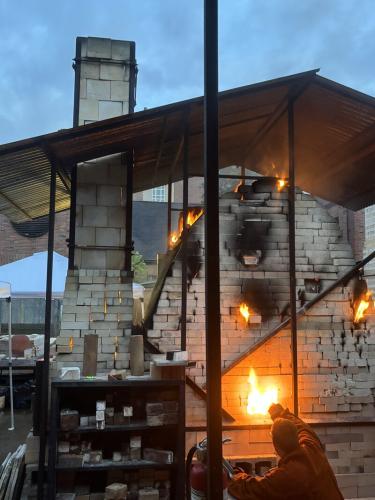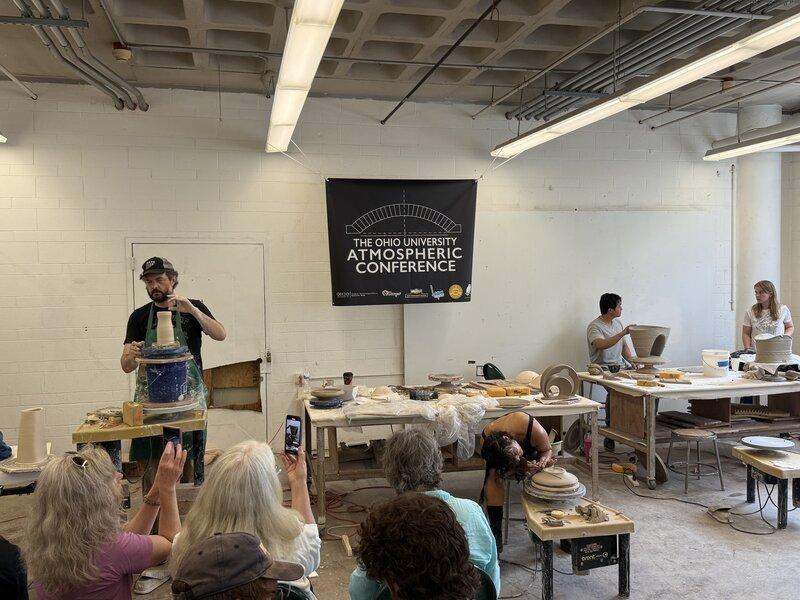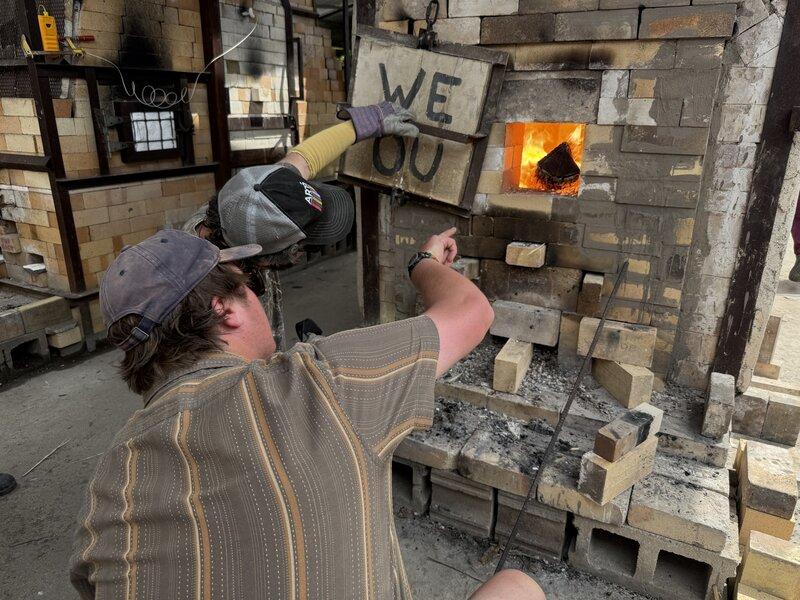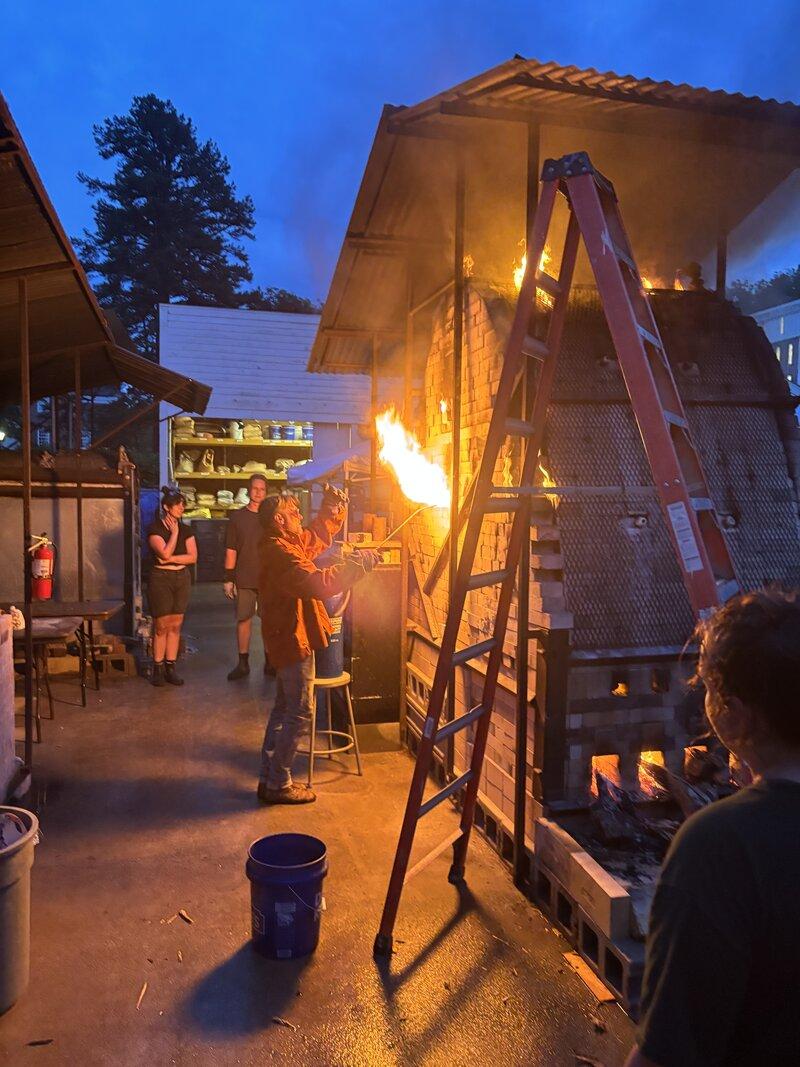
Ohio University Ceramics Program fires nine kilns in historic event as part of Atmospheric Conference

As part of The Atmospheric Conference, a landmark gathering of ceramic artists and experts from across the nation, the Ohio University School of Art + Design’s Ceramics Program recently accomplished an extraordinary feat: the simultaneous firing of nine atmospheric kilns. This ambitious endeavor marked a historic moment not just for the University, but for the broader ceramics community, demonstrating the unique capabilities and vision of OHIO’s nationally recognized program.
“Few, if any other institutions could achieve what is being done here,” Ben Eberle, one of the visiting artists from western Massachusetts, said. “I don’t think anywhere else in the profession they have the collection and diversity of kilns like what OHIO has built here. And this simultaneous firing of nine kilns at once is unprecedented.”

For the conference, the University welcomed 10 prominent ceramic artists and experts, along with students and practitioners from across the country, for a week of workshops, collaboration and dialogue. Participants glazed their work and prepared for the firings, sharing both technical knowledge and conceptual motivations behind their craft.
Artists traveled from as far as Florida and Seattle, joining peers from Mississippi, Minnesota, and many other states, converging in Athens for this rare opportunity to engage in collective making and discovery.

Firing multiple atmospheric kilns simultaneously is both a rare and deeply significant event in the world of ceramics. According to Duane McDiarmid, director of the School of Art + Design, each atmospheric kiln is unique, not only in design but also in the traditions and innovations it embodies.
“At OHIO, we are fortunate to have an unparalleled variety of kilns, many of which were built on-site over decades by faculty, visiting artists, and students. These kilns reflect a wide array of cultural influences and technical approaches, making every firing an exploration of history, chemistry, and artistry,” McDiarmid explained. “Atmospheric firing, which relies on the dynamic interaction of heat, flame, carbon, and minerals within the kiln, is a notoriously complex process. In the hands of true experts, many of whom have longstanding ties to our ceramics program, this process becomes an art of orchestration, where subtle adjustments to airflow and atmosphere produce deliberate and often stunning results.”
One such artist, Hayun Surl, a Korean artist and OHIO alumnus, returned for the conference. As a student, he built and fired a traditional-style downdraft kiln modeled after Korean kiln traditions, an enduring contribution to the program’s legacy.
What makes this particular event historic is not just the technical challenge, but the unprecedented scale and diversity of the firings. Few institutions can match the range of atmospheric kilns OHIO possesses, nor have they brought together such a breadth of leading artists and specialists to fire them concurrently. The simultaneous firings allowed for direct, side-by-side comparisons of methods and outcomes, turning the unloading of each kiln into a moment of shared insight and discovery.

“Students faculty and guest artists have steadily over many years built a collection of kilns, arguably unrivaled anywhere,” McDiarmid added. “These kilns that may look to the untrained eye like a ramshackle city of stacked bricks actually represent a collection of technology built over decades that represent related and diverse cultural histories from around the world—differing and sophisticated engineering and methodologies that combine glowing heat, material altered atmospheres and air circulation patterns that produce distinct results of color texture on ceramic surfaces.”
Atmospheric and wood-fired ceramics, like most art forms, are a delicate balance between skill and surrender. They represent the intersection of human mastery and natural, often unpredictable forces, creating powerful metaphors for the human condition. These processes are poetic acts of purpose, production, potential and humility. Through them, artists attempt to lay a table for the exchange of ideas that elevate humanity and address both personal and collective challenges.
The Atmospheric Conference was conceived and organized by graduate students Jason Wang and Sam McCall, with support from dozens of fellow ceramics students, faculty members, school administrators and University leadership.

